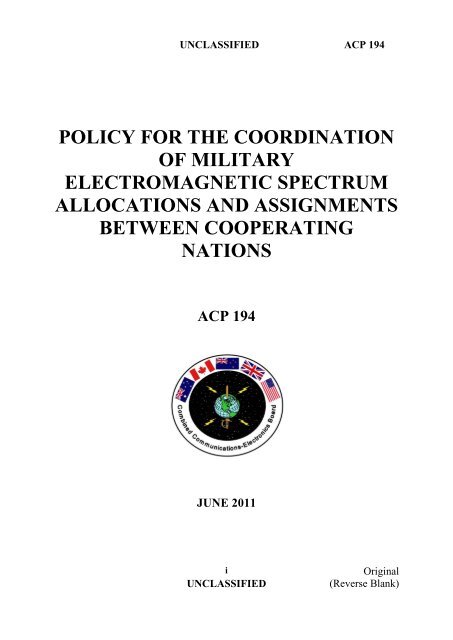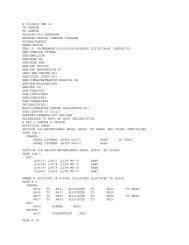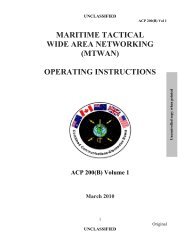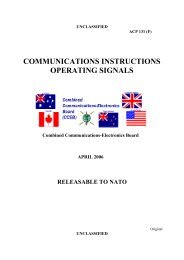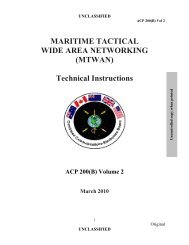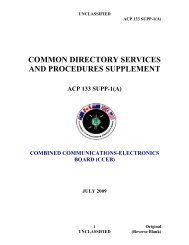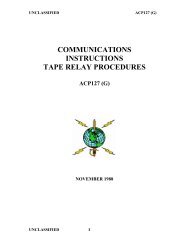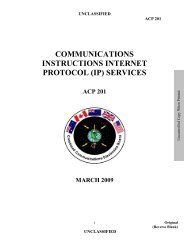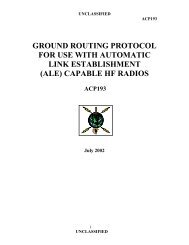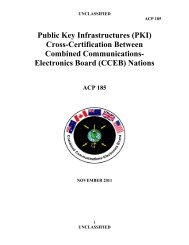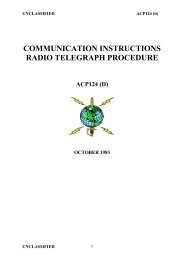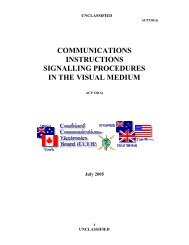ACP 194 - Multilateral Planners Conference
ACP 194 - Multilateral Planners Conference
ACP 194 - Multilateral Planners Conference
- No tags were found...
Create successful ePaper yourself
Turn your PDF publications into a flip-book with our unique Google optimized e-Paper software.
UNCLASSIFIED <strong>ACP</strong> <strong>194</strong>POLICY FOR THE COORDINATIONOF MILITARYELECTROMAGNETIC SPECTRUMALLOCATIONS AND ASSIGNMENTSBETWEEN COOPERATINGNATIONS<strong>ACP</strong> <strong>194</strong>JUNE 2011iUNCLASSIFIEDOriginal(Reverse Blank)
UNCLASSIFIED <strong>ACP</strong> <strong>194</strong>FOREWORD1 The Combined Communications-Electronics Board (CCEB) is comprised of the fivemember nations, Australia, Canada, New Zealand, United Kingdom and United States and isthe Sponsoring Authority for all Allied Communications Publications (<strong>ACP</strong>s). <strong>ACP</strong>s areraised and issued under common agreement between the member nations.2 <strong>ACP</strong> <strong>194</strong>, POLICY FOR THE COORDINATION OF MILITARYELECTROMAGNETIC SPECTRUM ALLOCATIONS AND ASSIGNMENTS BETWEENCOOPERATING NATIONS, is an UNCLASSIFIED CCEB publication.3 This publication contains Allied military information for official purposes only.4 It is permitted to copy or make extracts from this publication.5 This <strong>ACP</strong> is to be maintained and amended in accordance with the provisions of <strong>ACP</strong>198.iiiUNCLASSIFIEDOriginal(Reverse Blank)
UNCLASSIFIED <strong>ACP</strong> <strong>194</strong>THE COMBINED COMMUNICATIONS-ELECTRONICS BOARDLETTER OF PROMULGATION FOR <strong>ACP</strong> <strong>194</strong>1. The purpose of this Combined Communications-Electronics Board (CCEB) Letter ofPromulgation is to implement <strong>ACP</strong> <strong>194</strong> within the Armed Forces of the CCEB Nations. <strong>ACP</strong><strong>194</strong>, POLICY FOR THE COORDINATION OF MILITARY ELECTROMAGNETICSPECTRUM ALLOCATIONS AND ASSIGNMENTS BETWEEN COOPERATINGNATIONS, is an UNCLASSIFIED publication developed for Allied use under the directionof the CCEB Principals. It is promulgated for guidance, information, and use by the ArmedForces of the CCEB nations and NATO.2. <strong>ACP</strong> <strong>194</strong> is effective upon receipt for CCEB Nations and when directed by the NATOMilitary Committee (NAMILCOM) for NATO nations and Strategic Commands.EFFECTIVE STATUSPublicationEffective for Date Authority<strong>ACP</strong> <strong>194</strong> CCEB On Receipt LOP3. All proposed amendments to the publication are to be forwarded to the nationalcoordinating authorities of the CCEB or NAMILCOM.For the CCEB PrincipalPaul FosterPA FOSTERMajor CAFCCEB Permanent SecretaryvUNCLASSIFIEDOriginal(Reverse Blank)
UNCLASSIFIED <strong>ACP</strong> <strong>194</strong>RECORD OF MESSAGE CORRECTIONSIdentification of MessageCorrection and Date Time GroupDTGCorrectionDate EnteredEntered by(Signature, Name,rank)viiUNCLASSIFIEDOriginal(Reverse Blank)
UNCLASSIFIED <strong>ACP</strong> <strong>194</strong>TABLE OF CONTENTSTITLE PAGE............................................................................................................................. iFOREWORD ........................................................................................................................... iiiTHE COMBINED COMMUNICATIONS-ELECTRONICS BOARD LETTER OFPROMULGATION FOR <strong>ACP</strong> <strong>194</strong> ........................................................................................ vRECORD OF MESSAGE CORRECTIONS ....................................................................... viiTABLE OF CONTENTS ........................................................................................................ ixCHAPTER 1POLICY FOR THE COORDINATION OF MILITARY ELECTROMAGNETICSPECTRUM ALLOCATIONS AND ASSIGNMENTS BETWEEN COOPERATINGNATIONS ............................................................................................................................... 1-1INTRODUCTION ......................................................................................................... 1-1DEFINITIONS .............................................................................................................. 1-1OBJECTIVES OF MILITARY FREQUENCY MANAGEMENT.......................... 1-2ACHIEVEMENT OF FREQUENCY MANAGEMENT OBJECTIVES ................ 1-2STANDARD FREQUENCY ACTION FORMAT ..................................................... 1-3CHAPTER 2POLICY AND PROCEDURES FOR COORDINATION OF SPACEELECTROMAGNETIC SPECTRUM ASSIGNMENTS ............................................... 2-1INTRODUCTION ......................................................................................................... 2-1POLICY ......................................................................................................................... 2-1PROCEDURE ................................................................................................................ 2-1CHAPTER 3RESOLUTION OF HARMFUL INTERFERENCE ......................................................... 3-1INTRODUCTION ......................................................................................................... 3-1POLICY ......................................................................................................................... 3-1PROCEDURE ................................................................................................................ 3-1FORMAT FOR CLEARANCE OF INTERFERENCE MESSAGEANNEX A - STATION CAUSING INTERFERENCE ......................................... 3A-1TRANSMITTER STATION EXPERIENCING INTERFERENCE .................... 3A-1RECEIVING STATION EXPERIENCING INTERFERENCE ........................... 3A-2CHAPTER 4SPECTRUM REALLOCATION AND PRICING............................................................. 4-3INTRODUCTION ......................................................................................................... 4-3ixOriginalUNCLASSIFIED
UNCLASSIFIED <strong>ACP</strong> <strong>194</strong>INTERNATIONAL SPECTRUM MANAGEMENT DEVELOPMENTS ............. 4-3IMPLICATIONS OF SPECTRUM REALLOCATION AND PRICING ............... 4-3THE CASE AT THE NATIONAL LEVEL CASE FOR MILITARY SPECTRUMACCESS ......................................................................................................................... 4-4RESOURCES REQUIRED FOR PREPARATION OF MILITARY ARGUMENTS......................................................................................................................................... 4-6CONCLUSIONS............................................................................................................ 4-7CHAPTER 5AIDE-MÉMOIRE .................................................................................................................. 5-1MILITARY SPECTRUM REALLOCATION AND PRICING CONCERNS ............... 5-1INTRODUCTION ......................................................................................................... 5-1AIM ................................................................................................................................. 5-1MILITARY PRINCIPLES ........................................................................................... 5-1ECONOMIC FACTORS .............................................................................................. 5-3POLITICAL FACTORS .............................................................................................. 5-3CONCLUSION .............................................................................................................. 5-4RECOMMENDATION ................................................................................................ 5-4CHAPTER 6TABLE OF HARMONISED FREQUENCY BANDS ....................................................... 5-1INTRODUCTION ......................................................................................................... 5-1ANNEX A - CCEB TABLE OF HARMONISED FREQUENCY BANDS .................. 6A-1xUNCLASSIFIEDOriginal
UNCLASSIFIED<strong>ACP</strong> <strong>194</strong>CHAPTER 1POLICY FOR THE COORDINATION OF MILITARYELECTROMAGNETIC SPECTRUM (EMS) ALLOCATIONS ANDASSIGNMENTS BETWEEN COOPERATING NATIONSINTRODUCTION101. Nations, or coalitions of nations, are responsible for reviewing and coordinating theallocation and assignment of frequencies at the military-strategic level to satisfy their jointand combined military requirements. This requires the full coordination of allocationsand assignments necessary to ensure that spectrum-dependent (S-D) equipment issupportable in its intended operational electromagnetic environment; specifically toreduce the possibility of harmful interference across national boundaries and to support S-D equipment used by the forces of one nation while deployed in areas controlled byanother cooperating nation.DEFINITIONS102. For the purpose of military frequency management, the following definitions apply:a. Administration - Any governmental department or service responsible fordischarging the obligations undertaken in the Constitution of the InternationalTelecommunication Union (ITU) or in the Convention of the InternationalTelecommunication Union;b. Allocation (of a frequency band) - Entry in a Table of Frequency Allocationsof a given frequency band for the purpose of its use by one or more terrestrialor space radio communications services or the radio astronomy service underspecified conditions. This term shall also be applied to the frequency bandconcerned;c.d.e.Assignment (of a radio frequency or a radio frequency channel) -Authorisation given by a designated authority for a radio station to use afrequency or frequency channel under specified conditions;dHarmfulInterference – interference which endangers the functioning of aradionavigation service or of other safety services or seriously degrades,obstructs or repeatedly interrupts a radio communication service operating inaccordance with the ITU radio regulations;Battle space Spectrum Management (BSM) – In the context of thispublication, it is the application of the concepts of spectrum management inother than routine military operations.Spectrum Supportability. The process to provide military forces with S-Dequipment that is fully operable without EMS related limitations andinteroperable with other coalition equipment. SS generally involves threegeneral activities:–Equipment Certification – Initial coordination with coalition partners andHost Nation (HN) regulatory authorities to receive prior to finaldevelopment approval or guidance for S-D equipment intended to bedeployed into areas over which they have authority.1-1UNCLASSIFIEDOriginal
UNCLASSIFIED<strong>ACP</strong> <strong>194</strong>– Electromagnetic Environment Effects (E3) Control – Engineeringapplied throughout development to ensure that once the S-D equipmentis fielded/deployed, it can operate successfully within its electromagneticand operational environments–Frequency Assignment – Obtaining an actual assignment or authorization(license) with specific operating parameters (power, bandwidth, antennaht & gain, location, etc.) that allows the S-D equipment to operate.(Generally, the “expectation” of receiving a frequency assignment isinherent in favorable host nation comments on Equipment Certification)f. Spectrum Clearance - Spectrum Clearance is the process of obtaining anactual assignment (or ‘license’) with specific operating parametersOBJECTIVES OF MILITARY FREQUENCY MANAGEMENT103. The objectives of military Frequency Management between cooperating nations areas follows:a. The coordination of the allocation of frequency bands to equipment whereoperation of such equipment is likely to affect existing or future equipmentused by another nation (i.e., where there is a perceived interoperability orEMC issue);b. The exchange of information about national frequency allocations;c. To provide information on the technical and operational characteristics of theS-DD equipment being used or intended for use by each nation;d. To coordinate and obtain frequency assignments for a particular purpose (e.g.,transiting of aircraft, ships, etc);e. As part of EMS planning, coordinate and obtain frequency assignments whentwo or more nations are conducting combined or coalition operations orexercises; andf. To ensure that national administrations understand and represent asappropriate military spectrum requirements at international regulatory forums;g. To harmonize military frequency bands and military radio services allocationwithin bands to facilitate frequency interoperability between nations andensure that these radio services are EMC compatible within these bands;h. To coordinate, defend, and promote military interests in the radio spectrum atvarious national and internal meetings and conferences such as World Radio<strong>Conference</strong>s where international Radio Regulations are amended and have thestatus of treaty.ACHIEVEMENT OF FREQUENCY MANAGEMENT OBJECTIVES104. The objectives of military frequency management between cooperating nations areachieved as follows:a. Allocations of frequency bands to radio services are coordinated in1-2UNCLASSIFIEDOriginal
UNCLASSIFIED<strong>ACP</strong> <strong>194</strong>accordance with agreed procedures;b. Exchange of information about national allocations of frequency bands toequipment is achieved by exchanging national allocation tables andcirculating amendments as required;c. Information about the operational and emission characteristics of military S-Dequipment are exchanged in accordance with agreed procedures;d. As part of EMS planning, frequency assignments are coordinated inaccordance with agreed procedures;e. Large scale frequency assignments to support combined or coalitionoperations or exercises are coordinated in accordance with <strong>ACP</strong> 190, itssupplements, or in accordance with any more detailed and authoritativedocuments which may be produced for a particular operation or exercise; andf. Coordination of military spectrum requirements before meetings ofinternational regulatory forums is achieved by discussions at suitablemeetings, with circulation of relevant information papers before suchmeetings.COMMON EMS DATA EXCHANGE FORMAT105. While nations may depend upon and use different EMS management systems anddatabases, it is imperative that nations be able to exchange spectrum use data in acommon format that can be accepted by participating nations and when applicable, can beprocessed by each nation’s EMS management system.a. Standard Frequency Action Format(SFAF) : Refer to <strong>ACP</strong> 190 (B) Annex Efor details of the SFAF which is currently being used by the CCEB Nationsand other HNs for frequency proposals, assignments, modifications, renewals,reviews, and deletionsb.Spectrum Management Allied Data Exchange Format (SMADEF): eXtensibleMarkup Language (XML) Current Version. The CCEB has adopted for futureimplementation and use the SMADEF-XML which is being used withinNATO. Transition to SMADEF-XML, which is primarily machine-readable,involves the migration of existing databases and development/of new EMSmanagement tools and major modifications of existing EMS managementtools. Prior to full SMADEF-XML adoption, the CCEB will update <strong>ACP</strong>-190to reflect appropriate direction and guidance.1-3UNCLASSIFIEDOriginal
UNCLASSIFIED<strong>ACP</strong> <strong>194</strong>CHAPTER 2POLICY AND PROCEDURES FOR COORDINATION OF SPACERADIO FREQUENCY ASSIGNMENTSINTRODUCTION201. Coordination between nations of frequency assignments for space systems shouldbe effected as required, taking into account the provisions of the ITU Radio Regulations.POLICY202. To ensure that the military authorities of cooperating nations may adequatelyidentify, consider, and advise their national civil authorities with regard to the militaryspace systems of the other nations, information should be provided to the nations affectedthrough military channels before the submission of Advance Publication or CoordinationRequests to the ITU.PROCEDURE203. It is normal for satellite coordination meetings to take place directly betweensatellite operators (including military authorities) under the delegated authority of theirrespective national administrations. Meeting records are then passed to the nationaladministrations with a request to inform the ITU of the coordination status achieved.204. Whenever military space systems for which no international recognition will besought are to be established, coordination may nevertheless be desirable between themilitary authorities of co-operating nations. In such cases, the same elements ofinformation that would be required for international coordination should be exchangedbetween relevant military authorities as early as possible.2-1UNCLASSIFIEDOriginal(Reverse Blank)
UNCLASSIFIED<strong>ACP</strong> <strong>194</strong>INTRODUCTIONCHAPTER 3RESOLUTION OF HARMFUL INTERFERENCE301. Harmful interference is defined in paragraph 102.d.POLICY302. Within the congested portions of the EMS some interference can be expected andoften must be tolerated. Assignments of replacement frequencies should be consideredwhen efforts to alleviate harmful interference are ineffective.PROCEDURE303. When the source of harmful interference is considered to emanate from a station ofa cooperating nation, the military frequency-management authority for the stationsuffering interference should attempt to clear this interference directly with the militaryfrequency management authority of the nation to which the suspect interfering stationbelongs. If this attempt is unsuccessful, the interference should be reported by themilitary frequency-management authority for the station suffering interference to the civiladministration of that nation. The civil administration should be requested to refer thematter to the civil administration of the nation from where the interference is believed tobe emanating.Messages regarding clearance of interference should include certain essential elements ofinformation regarding the victim and source (when known) of the harmful interference.Some nations have established specific procedures and a format for the reporting ofinterference and when this guidance exists it should be followed. In the absence of anyrequired prescribed format or procedures, the format specified in Annex A to this chaptershould be used.3-1UNCLASSIFIEDOriginal(Reverse Blank)
UNCLASSIFIEDANNEX A TOCHAPTER 3 TO<strong>ACP</strong> <strong>194</strong>FORMAT FOR REPORTINGREPORTING EMS INTERFERENCESTATION CAUSING INTERFERENCEa. Name, call sign or other means of identificationb. (1) Frequency measured(2) Date(3) Time (UTC)c. Class of emission,d. Bandwidth (indicate whether measured or estimated)e. (1) measured field strength or power flux-density(2) Date(3) Timef. Observed polarisationg. Class of station and nature of serviceh. Location/position/area/bearingi. Location of the facility which made the above measurementsTRANSMITTER STATION EXPERIENCING INTERFERENCEj. Name, call sign or other means of identificationk. Frequency assigned1. (1) Frequency measured(2) Date(3) Time (UTC)m. Class of emissionn. Bandwidth (indicate whether measured or estimated)o. Location/position/areap. Location of the facility which made the above measurements3A-1UNCLASSIFIEDOriginal
UNCLASSIFIEDANNEX A TOCHAPTER 3 TO<strong>ACP</strong> <strong>194</strong>RECEIVING STATION EXPERIENCING INTERFERENCEq. Name of stationr. Location/position/areas. Dates and times (UTC) of occurrence of harmful interferencet. Bearings on other particularsu. Nature of interferencev. (1) Field strength or power flux-density of the wanted emission at thereceiving station experiencing the interference(2) Date(3) Time (UTC)w. Polarisation of the receiving antenna or observed polarisationx. Action requestedNOTES: 1. The class of emission shall contain the basic characteristics listedand if possible, the additional characteristics. If any characteristiccannot be determined, indicate the unknown symbol with a dash.2. When measurements are not available, signal strengths according tothe QSA scale (see <strong>ACP</strong> 131 (E)) should be provided.3A-2UNCLASSIFIEDOriginal
UNCLASSIFIED<strong>ACP</strong> <strong>194</strong>civil/industrial spectrum planning bodies. Military participation and advice can helpindustry avoid problems and may even help industry to identify commercial possibilities.416. The military arguments should highlight the following points:a. The total investment in military S-D systems, including the cost of systemdevelopment and expected service lifetime of these systems;b. The identification of vital spectrum interests and common frequency bands,especially when the physical characteristics of certain bands used by militaryare critical to military operations.c. The cost to relocate systems in the event they are displaced, along with thecost of any new replacement equipment if existing systems are forced intopremature retirement;d. A definition of vital military requirements during training and conflict,including requirements for today's systems as well as the systems of thefuture, must be prepared to support the military case;e. It is essential that the military demonstrate that the EMSEMS is being used inthe most effective and efficient manner possible. Continual reviewing offrequency band plans in light of new emerging S-D technology andidentification of future requirements, in a timely fashion, will assist in thistask;f. Some multinational military organisations have arranged common frequencybands in order to facilitate interoperability, despite the fact that such bands donot always exist on a worldwide basis. The military case will be strengthenedwhen it is shown that spectrum efficiency is being improved through the useof these common frequency bands and interoperable equipment;g. The existence of these harmonised bands may make them very attractive tonon-military government use and to the commercial sector, especially whencommercial organizations are seeking regional or world wide harmonisedbands for development of commercial personal communications systems.This possibility must be borne in mind and suitable arguments prepared tosafeguard these harmonised bands where they exist;h. Access to new spectrum will become difficult as spectrum reforms areenacted. Once spectrum has been reallocated to civil use, further militaryaccess may be denied unless prior sharing agreements have been set in place;i. The military may have to compete in the market place for continued spectrumaccess unless governments make separate provision for Defence and nationalsecurity.j. Adequate spectrum must be available to national Defence and to visitingforces for peacetime communications and training. This dictates that somespectrum must be reserved for these intermittent activities, giving rise to apossible perception of spectrum waste;k. The use of the spectrum by the military in peace time is not reflective of thetotal spectrum requirements during conflict. These additional combatrequirements have often been identified during exercises and operations and4-5OriginalUNCLASSIFIED
UNCLASSIFIED<strong>ACP</strong> <strong>194</strong>have been met by sharing with civil radio systems or obtaining allotments incivil bands;l. Difficulties which may occur if classified information cannot be madeavailable to support the military case. To overcome this the appropriatepersons in the civil administration must hold adequate security clearances;m. There is no peace dividend in military use of the spectrum. A peace dividendis illusory because reductions in military forces do not necessarily produceaccompanying reductions in spectrum requirements (unless complete systemsare cut); often the opposite is the case when reduced military forces must relyupon more S-D equipment to maintain comparable operational capabilities.At best, force reductions may produce a decrease in the frequency reusefactor. Regardless of ongoing force reductions, most military forces areadding radio and radar systems to their inventories. Commanders, faced withcuts in combat manpower, seek force multipliers in the areas of surveillanceand warning, target acquisition and, command and control all based on S-Dsystemsn. Spectrum lost to the military as a result of market based reforms in nationalspectrum management will not be recovered and may jeopardise current andfuture military capabilities.RESOURCES REQUIRED FOR PREPARATION OF MILITARY ARGUMENTS417. The preparation of the military arguments can only be completed with the assistanceof qualified staff. Initially, the identification of vital frequency bands would need to beaddressed by national military frequency management staffs in close coordinationoperational commanders and with colleagues in cooperating nations. Compilation ofequipment numbers, cost details and mission impact data is required if investmentarguments are to be presented. This collection is both essential and manpower intensiveand involves several military functional areas (procurement, supply, finance, operations,etc) to cover both current and future requirements.418. Legal Supporta. As the spectrum management reforms are legislative and binding on themilitary, legal support is required from the outset. Agreements may have tobe negotiated when spectrum that has been sold/auctioned is requiredtemporarily for exercises, training, humanitarian operations, etc. In theabsence of such agreements, the military could be held accountable for anyeconomic harm caused by harmful interference to businesses owningspectrum. This could result in legal action for the recovery of lost revenue bythe owner of the spectrum through the judicial system.b. There is a requirement for Defence legal staff to provide frequency plannerswith counsel regarding international and national regulations.419. Meetings between Military Spectrum Managers of Cooperating Nationsa. Recurring bi-lateral and multi-lateral military discussions are necessary if themilitary is to minimise the impact of the changes in national spectrummanagement. Although the reforms are national decisions, some advantage4-6UNCLASSIFIEDOriginal
UNCLASSIFIED<strong>ACP</strong> <strong>194</strong>can be gained in international fora such as the ITU by having priorcoordination discussions to attempt to influence national positions duringpreparations for meetings of such fora. Combined military efforts arerequired with continual information exchange and participation in periodicmeetings necessary to review and react to developments.b. To keep abreast of civil developments, and to ensure that Defence goals arereflected in national policies, it is essential that frequency planners work invarious civil symposia and conferences that address spectrum management.In particular, conferences such as the Asia Pacific Telecommunity, AfricanTelecommunications Union, European <strong>Conference</strong> of Postal and TelecommunicationsAdministrations, Inter-American Telecommunication Commission,League of Arab States, and the Pacific Telecommunications Council`ITU Radiocommunications Sector meetings and World Radiocommunication<strong>Conference</strong>s (WRCs) should be monitored/ attended and military interestsrepresented. The investment to attend such meetings/conferences is smallcompared to the losses that will result if spectrum is withdrawn420. Technical Developmentsa. Technical advances in electronic equipment over the last decade have enabledmore and different S-D systems to be introduced. The military can takeadvantage of these developments when replacing systems by utilizing newtechnologies for S-D equipment particularly employing tighter technicalspecifications, particularly in radio receivers. Introducing such equipmentinto the civil sector will also help in achieving these advantages as it reducesthe potential for harmful interference. New technologies such as dynamicspectrum access would permit greater opportunities for sharing resulting inmore efficient use of the spectrum. Use of data reduction techniques anddigital signal processing may relieve some of the congestion in spectrumusage.CONCLUSIONS421. Multinational military organisations and the many non-warfighting functions theyperform provide an effective case to generate international support for continued adequatemilitary access for use of the EMS. However, it remains that national spectrummanagement authorities will determine the use of the EMS within their boundaries.422. The military must be prepared to argue its case at a political level for continuedadequate spectrum access. These arguments must be based on military operationalrequirements reflecting government policies and must include emphasis on informingnon-military authorities of military spectrum requirements.423. To assist in developing national military arguments, adequate financial and legalresources must be provided to ensure that Defence goals are protected in international andnational regulatory and spectrum allocation forums.424. Spectrum lost will not be recovered. This may jeopardise access for future militarysystems and impose restrictions on current operations and training.4-7UNCLASSIFIEDOriginal
UNCLASSIFIED<strong>ACP</strong> <strong>194</strong>CHAPTER 5AIDE-MÉMOIREMILITARY SPECTRUM REALLOCATION AND PRICINGCONCERNSINTRODUCTION501. The EMS is a vital, but finite natural resource owned by each sovereign nation. It isthe sovereign right 2 of each nation to use the EMS, within its borders, in any manner itsees fit. With the rapid evolution and application of new radio technologies, there is anincreasing demand for spectrum for new services. The demand is expressed by bothnational and international agencies: commercial and private interests, internally, and inthe International Telecommunication Union (ITU), representing the world view at itsWorld Radiocommunication <strong>Conference</strong>s (WRCs).AIM502. This Aide-Mémoire aims to assist senior Defence staff in the task of protecting vitalmilitary interests which need spectrum.MILITARY PRINCIPLES503. Spectrum which is lost will not be recovered; sharing is preferable to loss. Thismight be described as the master principle. Some senior military officers, including somespectrum managers may talk about recovering spectrum from civil users in time ofcrisis/transition to war. This will only happen in extremes; otherwise, almost all spectrumwhich is being used by the civil sector will be incorporated into the national broadcastingand telecommunications infrastructure, both of which are vital to mobilisation and anywar effort. Inter-service sharing is common practice in the civil sector - it requires effortbut it can be made to work.504. Sharing is a two way street: There is a tendency in some civil administrations toconsider sharing only in the context of placing civil systems in spectrum reserved formilitary requirements. The argument needs to be made that sharing is a two way street,and that it is also necessary to examine spectrum reserved for civil purposes in order toascertain the extent to which military systems may operate in these bands.505. Military interests must be recognised and protected by administrations as part ofeach nation’s broad national interests. This is, in essence, the support that spectrummanagers desire from senior military leadership. Senior military leaders need torecognise that they are only one player (albeit, a very important one) in the highlycompetitive spectrum access game. This should not deter them however fromchampioning essential military spectrum access requirements whenever possible. Seniormilitary leaders should, indeed, seek out opportunities to meet with their civilcounterparts both in the radio communications industry and, especially, within thenational administration to clearly state the military’s essential spectrum requirements.506. Force reductions may generate increased demand for spectrum based systems.2 See the Preamble to the Constitution of the International Telecommunication Union.5-1UNCLASSIFIEDOriginal
UNCLASSIFIED<strong>ACP</strong> <strong>194</strong>This may be obvious to senior military leaders, but some civilian leaders have difficultywith the concept. In essence, force reductions, even major force reductions, do not,generally, reduce spectrum access requirements unless a complete class of S-D systems isretired. Force reductions are, often, accompanied by programmes which aim to offset theworst effects on combat capabilities by increasing the capabilities and capacities ofsurveillance, warning, target acquisition, weapon control and guidance and command andcontrol systems, almost all of which are highly, if not completely, dependent upon accessto the EMS. Therefore, far from reducing military spectrum access requirements, forcereductions tend to actually increase spectrum use to maintain the same operationalcapabilities.507. The increasing operational requirements and the performance requirements of S-Dsystems required to meet those operational requirements result in increased EMSbandwidth demands.a. One example is improving surveillance capabilities. The laws of physics areat work here. To track smaller missiles, moving more quickly and closer to thewave tops then it is necessary to increase bandwidth - there is a limit to thegains which signal processing can make. Before the information can beprocessed enough information must be acquired for analysis to occur.b. Another example is the increased use of unattended aerial vehicles (UAVs)over piloted aircraft for surveillance and weapons delivery. While the UAVsare less costly than pilot training and fighter/surveillance aircraft, the need toremotely control the UAV and the use of full motion video results insignificant increases in spectrum access requirements.508. Military spectrum use is tied to military tasks and functions which are establishedand tasked by governments, often distinct from warfighting such as humanitarian orrelieve operations. Loss of spectrum may prejudice the tasks or dictate unexpectedprocurement requirements for replacement systems. This is a political/public policyconsideration which should be meaningful to senior officials in the nationaladministration.509. Interference from/to military systems will have an adverse effect on operations.a. For example, a change in naval operations from “blue water" to “littoralwater” has increased the likelihood of interference between maritime andshore based radio systems. A similar situation applies when training areas aredecreased. Although the same amount of spectrum is required, thegeographical area is smaller and may be closer to populated areas resulting inan increased potential to cause harmful interference to other military users ornon-military spectrum.510. Spectrum use is constrained by treaty obligations. Multi-national militaryobligations may be used to justify spectrum access. In the case of Europe, the Europeanindustry respects the civil/military NATO Joint Frequency Agreement (NJFA) which hasset aside certain “harmonized” bands for NATO use throughout NATO Europe as well asin the Partners-for-Peace nations that cooperate military operations with NATO . TheITU Radio Regulations (RRs) in conjunction with national ratification of these RRsconstitute a treaty regarding spectrum use and the military, by using "out of band"systems without specific host nation approval violates the provisions of that treaty.5-2UNCLASSIFIEDOriginal
UNCLASSIFIED<strong>ACP</strong> <strong>194</strong>511. Spectrum must be reserved for contingencies and survivability. There is a vitaloperational requirement which covers, for example, most of the l215 - 1400 MHz bandswhich are used to provide Electronic Countermeasures (ECM) protection for Naval radarsand all the channels which are reserved in COMMPLANS. As far as military spectrummanagers are concerned these "reserved" contingency channels are licensed and assignedto military users. To civil users theses channels, while not continuously used may bemisperceived as evidence that the military is not using spectrum efficiently.ECONOMIC FACTORS512. EMS spectrum access is vital for economic development. Senior military officersmust be prepared for and accept this point. It will be raised by private sector executivesand by senior officials in the national administrations acting in support of theirgovernments' efforts to increase national prosperity and create jobs.513. Spectrum has a real capital value which is growing and can generate revenue. Amarket based approach to spectrum pricing may make sharing very difficult. There arereally two factors here. The first concerns the capital value of the spectrum. It isindisputable. In countries where spectrum cannot be traded like any other commodity, thevalue of the spectrum is appreciated by those who have to pay for it. The second factor isthat when the national regime allows for spectrum to be traded, then sharing (the masterprinciple) without cost reimbursement can be very difficult. It is possible however, todesign regulatory regimes which can allow both spectrum rights and sharing.514. Spectrum can be seen as a commodity which can be traded. This is a fact. Someorganisations see the spectrum as investment opportunities which can increase in valueand then traded for profit. This could encourage spectrum hoarding.515. Military S-D capabilities represent a national capital investment. This is also a fact,however it is often understated or overlooked.516. Military budgets are not as flexible as commercial funding. This is anotherimportant factor which is often unappreciated by executives in the private sector: theservice life of military S-D systems. Civil systems have evolved in response to growingand increasingly sophisticated consumer demand and may have a short service lifetimebefore being replaced by more sophisticated systems. Robust military systems, on theother hand, may have very long service lifetimes, are often employed well past theirprojected end-of-service dates, and may not employ the most modern, spectrum efficienttechnology due to the somewhat dated technology being employed.517. Competition in the market place can result in unused spectrum. This factor relatesto the duplication of systems and services which results when, for example, a number oftelecommunications service providers in a country may each have national networks. It ispossible that none may use their available spectrum to capacity.POLITICAL FACTORS518. National spectrum management is subject to international regulations and pressures.This is, in part, a repeat of the “treaty" factor above but with the addition of the aspect ofpressures to conform. This is especially relevant to countries with a small economic basewhich border larger, more dynamic economies.519. The perceived reduction in the direct military threat encourages a demand for apeace dividend in the spectrum. See discussion under "force reductions" above.5-3OriginalUNCLASSIFIED
UNCLASSIFIED<strong>ACP</strong> <strong>194</strong>CONCLUSION520. The need for military spectrum must be understood by both military and nationalsenior civil management. This is a statement of the obvious. There are a few others:a. The military must recognise that it is in a competition for spectrum.b. The military must recognise that its mission may not entitle it to an automaticplace at the head of the spectrum line.c. The military must recognise that its practices and procedures cause civilians inthe private sector and in the national administration to see waste where themilitary sees only flexibility or budget restrictions.RECOMMENDATION521. Every opportunity should be taken to present to senior military and civilian officialsthe case for military access to the EMS. This is, indeed, about all that senior militaryofficers can be expected to do. The battle for spectrum access must be waged on severalfronts. While the spectrum managers are the main combatants, senior military leaders canand must play a very important supporting role - especially in fora not normally availableto the spectrum managers.5-4UNCLASSIFIEDOriginal
UNCLASSIFIEDCHAPTER 6LIST OF FREQUENCY BANDSCOMMONLY USED BY CCEB NATIONS<strong>ACP</strong> <strong>194</strong>INTRODUCTION601. The table in the Annex to this chapter is a list of spectrum bands that are used bymilitary forces in the CCEB nations, which are located in all three ITU Regions.602. The Table is intended to only be used as a long range planning tool and SHOULDNOT be used as a final reference in lieu of coordinating with, and seeking commentsfrom, either host nations on use of the EMS within their national borders or fromestablished military organizations which may have authority over a particular region,operation, or mission.603. The Table also shows, for all three ITU Regions, that some spectrum usage bymilitary forces of the CCEB nations may be similar and may enhance the interoperabilityof coalition forces and their ability to act in concert in Joint and Combined Operations.6-1UNCLASSIFIEDOriginal(Reverse Blank)
UNCLASSIFIED<strong>ACP</strong> <strong>194</strong>CCEB TABLE OF HARMONISED FREQUENCY BANDSIn the following tables, the CCEB Members identified in accordance with the following table, which also shows the ITU Region in which theMember is located.CCEB Member ITU Region CountryAbbreviationAustralia 3 AUCanada 2 CANew Zealand 3 NZUnited Kingdom 1 UKUnited States 2 USFrequency Band Military Requirements/Usage Participating CCEB NationsAU CA NZ UK US14-70 kHz Low Frequency Communications and Sounders for Submarines X X X X70-148.5 kHz Naval Communications. X X X X255-283.5 kHz Air Navigation and Beacons. X X X X X283.5-415 kHz Tactical Non-Directional Beacons. X X X X X415-526.5 kHz Tactical Non-Directional Beacons. X X X X XNaval and Fixed Ground Communications. X X X1606.5 kHz - 30 MHz Long Distance Airborne Communications./ (ALSO HAS BEACONS) X AUa X X X XAUa Also used in Australia for portable Non-Directional Beacons.UNCLASSIFIED
UNCLASSIFIED<strong>ACP</strong> <strong>194</strong>Frequency Band Military Requirements/Usage Participating CCEB NationsTelephony Duplex/Simplex Channels; Wideband Telegraphy Channels;& Naval Communications.AU CA NZ UK USX X X X XFixed and Tactical Communications. X X X X XOver-the-Horizon Radars X AU1 X X30-87.5 MHz Army Air Force and Navy Tactical/Combat Net Radio Systems. (SeeEnd Notes 1 and 2)X AUb X CA1 X NZ1 X X87.5-108 MHz Army and Air Force Tactical/Combat Radio Systems. X US 1108-136 MHz Aeronautical Radionavigation and Aeronautical Mobile(R) X X X X138-144 MHz Air Traffic Control Communications. X UK1 XLand Mobile Communications and Sonobuoy Operations. (SOUNDERS) X AU2 X X X X148-149.9 MHz Land Mobile Communications. (NAVAL COMMUNICATIONS/FIXED)US2X AUc X X UK2 X150-150.8 MHz Land Mobile Communications. X AUc X XAU1 For AU, 3025 kHz - 45 MHzAUb Additional Military uses by Australia in this band.CA1 In Canada, Combat Net Radio operation outside the band 30-50 MHz is unlikely.NZ1 Portions of this band are unavailable due to other national civil usage BroadcastingUS 1 Navy has a few SINCGARS assignments in 87.5-88 operation on OOB basis with note RR 1.144 applied.US2 88 – 108 MHz is allocated in the U.S. on an exclusive basis to civil FM broadcasting.UK1 In UK 142.5 – 143 MHz.AU2 In Australia the band 137-144 MHz is used for TV in some areas. Some geographic restrictions exist to military access to this band.AUc Australia also has Sonobouy Operations within this band.UK2 In UK 149-149.9 MHz.UNCLASSIFIED
UNCLASSIFIED<strong>ACP</strong> <strong>194</strong>Frequency Band Military Requirements/Usage Participating CCEB NationsAU CA NZ UK US150.8-156 MHz Land Mobile Communications US2 X AUd X X UK3 X156-174 MHz Sonobuoy Operations at Sea and in Port (For UK and NZ, 136-174 MHz) X X X X XNaval Communications. X AUb X X X X174-225 MHz Land Mobile Communications and Broadcast. X225-400 MHz Navy, Army and Air Force Tactical Command and Control. Tactical X AU3 X X NZ2 X X US3Satellite. (See End Note 3)400.15-406 MHz Meteorological Aids and Meteorological Satellite Service. X X X X X406.1-420 MHz Land Mobile Communications.AUeXX UK4AUc Australia also has Sonobouy Operations within this band.US2 In U.S. 152.0075 & 163.250 MHz, authorized for medical radiocommunication systems on a primary basis; otherwise no US allocation for Federal (military) use. Allmilitary use is OOB.AUd Australia also has Sonobuoy Operations and other Military uses within this band.UK3 In UK 153.5-154MHzAUb Additional Military uses by Australia in this band.AU3 In Australia the band is 230-400 MHz.NZ2 In New Zealand the band is 230-400 MHzNZ3In New Zealand the band 494-502MHz is for PPDR communicationsUS3 In U.S., military ILS and Air Traffic Control functions are also in this band.AUe 403-430 MHz is planned as a future Australian Government band. Temporary licences may be available for Military use on Ad-Hoc basis.UK4 In UK, Land Mobile use onlyUNCLASSIFIED
UNCLASSIFIED<strong>ACP</strong> <strong>194</strong>Frequency Band Military Requirements/Usage Participating CCEB NationsAU CA NZ UK USLaunch Booster Safety Systems. US4Land, Naval and Airborne Radars.420-450 MHz Land Mobile, Radar (Not sure if DoD has LMR operations in this band) X AUf X X X450-581.9 MHz Land and Aeronautical Mobile. X AUb X NZ3 X582-606 MHz Land Mobile Communications X606-790 MHz Broadcasting and Radar Site Communications.AUbX790-960 MHz Army and Air Force Tactical Command and Control (point to point links)Interconnecting Communications Centres.XNaval Air Search Radars X AU4 X X NZ4X960-1215 MHz(See End Note 10)TACAN/DME (Air Navigation) X X X X XJTIDS/MIDS (TDMA Naval Air and Land Control Links) X X X X XUS4 NTIA manual calls for discontinuation of these operations in the 406.1-420 MHz band as of 31 Dec 87. The NTIA manual also states that these operations should becarried out in the 420-450 MHz band.AUf Military use restricted to between 430-450 MHz in Australia.AUb Additional Military uses by Australia in this band.AUb Additional Military uses by Australia in this band.AU4 in Australia the band is 850-942 MHzNZ4 in New Zealand the band is 850-942 MHzUNCLASSIFIED
UNCLASSIFIED<strong>ACP</strong> <strong>194</strong>Frequency Band Military Requirements/Usage Participating CCEB NationsAU CA NZ UK US1215-1350 MHz NAVSTAR Global Positioning System.X X X X XLong Range Air Defence Warning Radars. US51350-1400 MHz Long Range Air Defence Warning Radars. US6 X X X1350-1610 MHz Army and Air Force Tactical, Mobile, Global Positioning System,Airborne Telemetry, and Naval Radar.X X X X UK5 X US71670-1700 MHz Meteorological Aids X X X1755-1850 MHz Army, Air Force and Navy Fixed and Mobile, Space Operations inX XRegion 22200-2290 MHz Fixed links, Space Operations (Downlinks), Mobile) X UK6 X2300-2450 MHz Airborne Telemetry X CA2 X NZ5 X UK7 X US82700-3100 MHz Navy, Army and Air Force Surveillance Radars. X X X X X3100-3410 MHz Navy, Army and Air Force Radars. X X X X X3410-3650 MHz Naval and Land Based Radars X X XUS5 GPS L2 emissions extend from 1215-1240 MHz centred on 1227 MHz.US6 Radar use limited to 1350-1390 MHz.UK5 In UK only 1375-1400, 1429-1452 and 1559-1610 MHz is available for military use.US7 Global Navigation Satellite Systems authorised in 1559-1610 MHz band.UK6 In UK, Mobile Service from 2200 – 2245 MHz and Space Operations from 2200 – 2290 MHz.NZ5In NZ airborne telemetry is limited to 2400-2483MHzCA2 In Canada airborne telemetry is limited to 2360 – 2400 MHzUK7 In UK telemetry operates between 2310 – 2400 MHz only.US8 The U.S. authorises airborne telemetry only in the 2360-2390 MHz band.UNCLASSIFIED
UNCLASSIFIED<strong>ACP</strong> <strong>194</strong>Frequency Band Military Requirements/Usage Participating CCEB NationsAU CA NZ UK US4200-4400 MHz Radio Altimeters. X X X X X4400-5000 MHz Fixed and Mobile Command and Control and Tactical Radio Relay(See End Note 2)5000-5150 MHz Airborne radar and Microwave Landing Systems (5030-5150 MHz perRR 5.444).X X X XX X X5250-5925 MHz Navy, Army and Air Force Radars. X X X X X5920-7250 MHz Fixed and Fixed-Satellite Communications.(US Fixed starts at 7125 MHz)7250-7750 MHz Satellite Downlinks, Mobile Satellite for Naval and Land Mobile EarthStations, Fixed Systems. ( See End Note 4)X X XX X X X7750-7900 MHz Fixed Systems X X7900-8400 MHz Satellite Uplinks, Naval and Land Mobile Satellite Earth Stations, EarthExploration Satellite Downlinks, and Fixed Systems. (See End Note 4 &5)X X X X8400-8500 MHz Fixed and Mobile systems. X X8500 MHz -10.7 GHz Navy, Army and Air Force Radars. X X X X UK8 X10.7-13.4 GHz Target Tracking and Lock-On Systems. X13.4-14.0 GHz Navy, Army and Air Force Radars. X X X X XUK8 In UK, military radiolocation allocation ends at 10.50 GHz.UNCLASSIFIED
UNCLASSIFIED<strong>ACP</strong> <strong>194</strong>Frequency Band Military Requirements/Usage Participating CCEB NationsAU CA NZ UK US14.62-15.23 GHz Operational Command and Control. (See End Note 2) X X X X X15.4-15.7 GHz Airborne Radars. X15.7-17.3 GHz Navy, Army and Air Force Radars. (See End Note 5) X X X X X17.3-17.7 GHz Navy, Army and Air Force Radars. (See End Note 11) X X17.7-20.2 GHz Space and Fixed Systems. X X20.2-21.2 GHz Satellite Downlinks. (See End Note 3) X X X X X21.2-24.05 GHz Fixed Microwave Communications. X X24.05-24.25 GHz Radars X X25.25-27.5 GHz Operational Command and Control (Existing or Planned SatelliteSystems).X X X X30-31 GHz Planned Satellite Uplinks. (See End Note 3&7) X X X X X33.4-36.0 GHz Radar Systems. (See End Note 3) X X X X36-37 GHz Fixed, Mobile and Planned Satellite Systems. ( See End Note 3) X X X X37-39.5 GHz Existing and Future Fixed and Satellite Systems. X X X39.5-40.5 GHz Future Satellite Downlinks. (See End Note 3&8) X X X43.5-45.5 GHz Satellite Uplinks and Mobile Systems. (See End Note 3) X X X X50.4-51.4 GHz Future Satellite Uplinks and Planned Terrestrial Systems. (See End Note3)X X X54.25-58.2 GHz Planned Aeronautical Mobile and Satellite Systems. XUNCLASSIFIED
UNCLASSIFIED<strong>ACP</strong> <strong>194</strong>Frequency Band Military Requirements/Usage Participating CCEB Nations59-64 GHz Planned and Existing fixed, Mobile, Radiolocation, IntersatelliteCommunications and Wireless Computer Systems. (See End Note 9)AU CA NZ UK USX X X X66-71 GHz Future Satellite and Land Mobile Systems. X X71-74 GHz Future Satellite Uplinks. (See End Note 8) X X74-75.5 GHz Future Fixed, Mobile and Satellite Systems. X76-81 GHz Future Radar Systems. X X X X81-84 GHz Future Satellite Downlinks. (See End Note 8) X X92-95 GHz Future, Planned and Existing Radar, Fixed, Mobile and Satellite Systems. X X X X95-100 GHz Future, Planned and Existing Radar Systems. X X X X126-134 GHz Future, Command and Control, Radar and Intersatellite Systems. X134-142 GHz Future and Planned Mobile and Radar Systems. X144-149 GHz Future Radar Systems. X190-265 GHz Future Radionavigation and Mobile Systems.231-235 GHz Future Fixed and Satellite Systems.235-241 GHz Future Fixed and Mobile Systems and Satellite Downlinks.241-248 GHz Future Radar Systems.UNCLASSIFIED
UNCLASSIFIED<strong>ACP</strong> <strong>194</strong>Frequency Band Military Requirements/Usage Participating CCEB NationsAU CA NZ UK US252-265 GHz Future Mobile Systems.300-1000 GHz Infrared Technology Development. X US9NOTES45-47 MHz is harmonised NATO band type 1 (46.60-47 MHz also accessible by the military in ITU region 2).This is a harmonised NATO band type 1.This is a harmonised NATO band type 1, including ITU region 2.This is a harmonised NATO band type 1 for satellite downlinks.This is a harmonised NATO band type 1 for satellite uplinks.15.7-17.1 GHz is a harmonised NATO band type 1.This is a harmonised NATO band type 2.This is a harmonised NATO band type 3 including ITU Region 2.59-61 GHz is a harmonised NATO band type 2 including ITU Region 2.Global Navigation Satellite Systems are authorized in the 1164-1215 MHz band.Radiolocation is allowed in this band on a secondary basis to fixed systems and satellite uplink or downlink systems, depending on the ITU region involved.NATO band type 1: a frequency band that is in general military use in NATO Europe.NATO band type 2: a frequency band that is planned for military use in NATO Europe.NATO band type 3: a frequency band that is has been identified for possible military use in NATO Europe.US9 In the U.S., reference is made to NTIA Allocation Table, 5.565 and US 375UNCLASSIFIED


